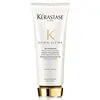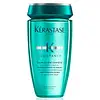What's inside
What's inside
 Key Ingredients
Key Ingredients

 Benefits
Benefits

 Concerns
Concerns

 Ingredients Side-by-side
Ingredients Side-by-side

Water
Skin ConditioningCetearyl Alcohol
EmollientAmodimethicone
Glycerin
HumectantCetyl Esters
EmollientCetrimonium Chloride
AntimicrobialDipalmitoylethyl Hydroxyethylmonium Methosulfate
Trideceth-6
EmulsifyingPhenoxyethanol
PreservativeBenzyl Salicylate
PerfumingHexyl Cinnamal
PerfumingChlorhexidine Digluconate
AntimicrobialBenzyl Alcohol
PerfumingLinalool
PerfumingLimonene
PerfumingCitric Acid
BufferingCitronellol
PerfumingZea Mays Germ Oil
EmollientArgania Spinosa Kernel Oil
EmollientCamellia Oleifera Seed Oil
Skin ConditioningCaprylic/Capric Triglyceride
MaskingGeraniol
PerfumingCaramel
Cosmetic ColorantCI 19140
Cosmetic ColorantCI 17200
Cosmetic ColorantPhyllanthus Emblica Fruit Extract
HumectantTocopherol
AntioxidantParfum
MaskingWater, Cetearyl Alcohol, Amodimethicone, Glycerin, Cetyl Esters, Cetrimonium Chloride, Dipalmitoylethyl Hydroxyethylmonium Methosulfate, Trideceth-6, Phenoxyethanol, Benzyl Salicylate, Hexyl Cinnamal, Chlorhexidine Digluconate, Benzyl Alcohol, Linalool, Limonene, Citric Acid, Citronellol, Zea Mays Germ Oil, Argania Spinosa Kernel Oil, Camellia Oleifera Seed Oil, Caprylic/Capric Triglyceride, Geraniol, Caramel, CI 19140, CI 17200, Phyllanthus Emblica Fruit Extract, Tocopherol, Parfum
Water
Skin ConditioningSodium Laureth Sulfate
CleansingCoco-Betaine
CleansingTaurine
BufferingCocamide Mipa
EmulsifyingSodium Chloride
MaskingAmodimethicone
Laureth-5 Carboxylic Acid
CleansingPPG-5-Ceteth-20
EmulsifyingSodium Benzoate
MaskingPolyquaternium-10
PEG-55 Propylene Glycol Oleate
Propylene Glycol
HumectantPEG-60 Hydrogenated Castor Oil
EmulsifyingSalicylic Acid
MaskingAmyl Cinnamal
PerfumingHexyl Cinnamal
PerfumingBenzyl Alcohol
PerfumingLinalool
PerfumingHydroxycitronellal
PerfumingCitronellol
PerfumingLimonene
PerfumingCreatine
Skin Conditioning2-Oleamido-1,3-Octadecanediol
Skin ConditioningBenzyl Cinnamate
PerfumingSodium Acetate
BufferingIsopropyl Alcohol
SolventSodium Hydroxide
BufferingCitric Acid
BufferingParfum
MaskingWater, Sodium Laureth Sulfate, Coco-Betaine, Taurine, Cocamide Mipa, Sodium Chloride, Amodimethicone, Laureth-5 Carboxylic Acid, PPG-5-Ceteth-20, Sodium Benzoate, Polyquaternium-10, PEG-55 Propylene Glycol Oleate, Propylene Glycol, PEG-60 Hydrogenated Castor Oil, Salicylic Acid, Amyl Cinnamal, Hexyl Cinnamal, Benzyl Alcohol, Linalool, Hydroxycitronellal, Citronellol, Limonene, Creatine, 2-Oleamido-1,3-Octadecanediol, Benzyl Cinnamate, Sodium Acetate, Isopropyl Alcohol, Sodium Hydroxide, Citric Acid, Parfum
Ingredients Explained
These ingredients are found in both products.
Ingredients higher up in an ingredient list are typically present in a larger amount.
This water-soluble silicone is used for its hydrating and softening properties. It is used to add a silky feel to skincare products and has great benefits for haircare.
In haircare, this ingredient:
- Adds shine
- Protects color
- Offers thermal protection
- Boosts hair strength
- Does not build up as easily
Benzyl Alcohol is most commonly used as a preservative. It also has a subtle, sweet smell. Small amounts of Benzyl Alcohol is not irritating and safe to use in skincare products. Most Benzyl Alcohol is derived from fruits such as apricots.
Benzyl Alcohol has both antibacterial and antioxidant properties. These properties help lengthen the shelf life of products. Benzyl Alcohol is a solvent and helps dissolve other ingredients. It can also improve the texture and spreadability.
Alcohol comes in many different forms. Different types of alcohol will have different effects on skin. This ingredient is an astringent alcohol.
Using high concentrations of these alcohols are drying on the skin. They may strip away your skin's natural oils and even damage your skin barrier. Astringent alcohols may also irritate skin.
Other types of astringent alcohols include:
According to the National Rosacea Society based in the US, you should be mindful of products with these alcohols in the top half of ingredients.
Any type of sanitizing product will have high amounts of alcohol to help kill bacteria and viruses.
Learn more about Benzyl AlcoholCitric Acid is an alpha hydroxy acid (AHA) naturally found in citrus fruits like oranges, lemons, and limes.
Like other AHAs, citric acid can exfoliate skin by breaking down the bonds that hold dead skin cells together. This helps reveal smoother and brighter skin underneath.
However, this exfoliating effect only happens at high concentrations (20%) which can be hard to find in cosmetic products.
Due to this, citric acid is usually included in small amounts as a pH adjuster. This helps keep products slightly more acidic and compatible with skin's natural pH.
In skincare formulas, citric acid can:
While it can provide some skin benefits, research shows lactic acid and glycolic acid are generally more effective and less irritating exfoliants.
Most citric acid used in skincare today is made by fermenting sugars (usually from molasses). This synthetic version is identical to the natural citrus form but easier to stabilize and use in formulations.
Read more about some other popular AHA's here:
Learn more about Citric AcidCitronellol is used to add fragrance/parfum to a product. It is often derived from plants such as roses. In fact, it can be found in many essential oils including geranium, lavender, neroli, and more. The scent of Citronellol is often described as "fresh, grassy, and citrus-like".
Since the Citronellol molecule is already unstable, Citronellol becomes irritating on the skin when exposed to air.
Citronellol is a modified terpene. Terpenes are unsaturated hydrocarbons found in plants. They make up the primary part of essential oils.
Citronellol is not able to be absorbed into deeper layers of the skin. It has low permeability,
Citronellol is also a natural insect repellent.
Learn more about CitronellolHexyl Cinnamal is a fragrance ingredient with a similar scent to jasmine. It can be naturally found in chamomile essential oil.
This ingredient is a known EU allergen and may sensitize the skin. The EU requires this ingredient to be listed separately on an ingredients list.
Hexyl Cinnamal is not water soluble but is soluble in oils.
Learn more about Hexyl CinnamalLimonene is a fragrance that adds scent and taste to a formulation.
It's found in the peel oil of citrus fruits and other plants such as lavender and eucalyptus. The scent of limonene is generally described as "sweet citrus".
Limonene acts as an antioxidant, meaning it helps neutralize free radicals.
When exposed to air, oxidized limonene may sensitize the skin. Because of this, limonene is often avoided by people with sensitive skin.
The term 'fragrance' is not regulated in many countries. In many cases, it is up to the brand to define this term. For instance, many brands choose to label themselves as "fragrance-free" because they are not using synthetic fragrances. However, their products may still contain ingredients such as essential oils that are considered a fragrance.
Learn more about LimoneneLinalool is a fragrance and helps add scent to products. It's derived from common plants such as cinnamon, mint, citrus, and lavender.
Like Limonene, this ingredient oxidizes when exposed to air. Oxidized linalool can cause allergies and skin sensitivity.
This ingredient has a scent that is floral, spicy tropical, and citrus-like.
Learn more about LinaloolParfum is a catch-all term for an ingredient or more that is used to give a scent to products.
Also called "fragrance", this ingredient can be a blend of hundreds of chemicals or plant oils. This means every product with "fragrance" or "parfum" in the ingredients list is a different mixture.
For instance, Habanolide is a proprietary trade name for a specific aroma chemical. When used as a fragrance ingredient in cosmetics, most aroma chemicals fall under the broad labeling category of “FRAGRANCE” or “PARFUM” according to EU and US regulations.
The term 'parfum' or 'fragrance' is not regulated in many countries. In many cases, it is up to the brand to define this term.
For instance, many brands choose to label themselves as "fragrance-free" because they are not using synthetic fragrances. However, their products may still contain ingredients such as essential oils that are considered a fragrance by INCI standards.
One example is Calendula flower extract. Calendula is an essential oil that still imparts a scent or 'fragrance'.
Depending on the blend, the ingredients in the mixture can cause allergies and sensitivities on the skin. Some ingredients that are known EU allergens include linalool and citronellol.
Parfum can also be used to mask or cover an unpleasant scent.
The bottom line is: not all fragrances/parfum/ingredients are created equally. If you are worried about fragrances, we recommend taking a closer look at an ingredient. And of course, we always recommend speaking with a professional.
Learn more about ParfumWater. It's the most common cosmetic ingredient of all. You'll usually see it at the top of ingredient lists, meaning that it makes up the largest part of the product.
So why is it so popular? Water most often acts as a solvent - this means that it helps dissolve other ingredients into the formulation.
You'll also recognize water as that liquid we all need to stay alive. If you see this, drink a glass of water. Stay hydrated!
Learn more about Water